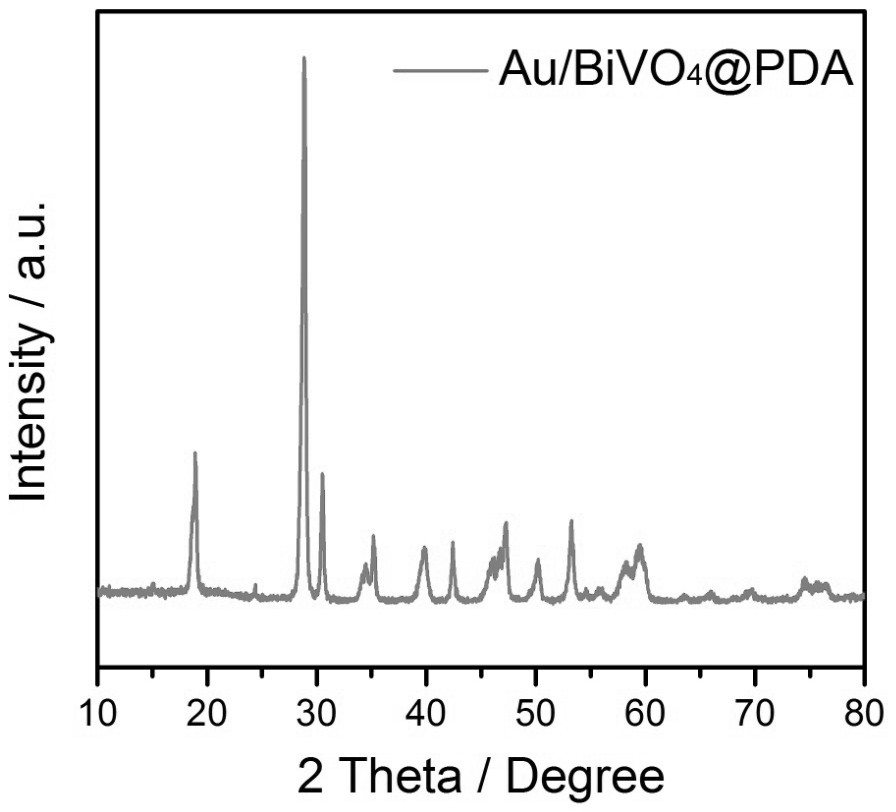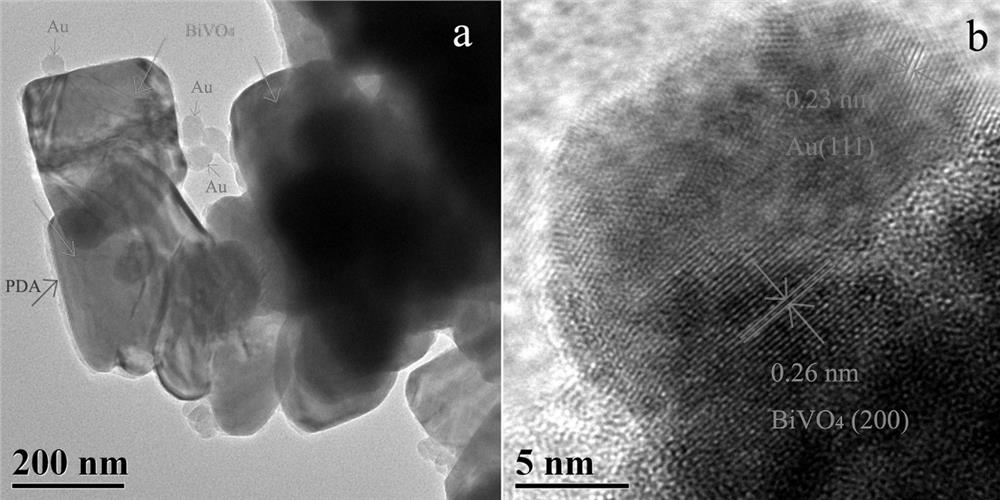Preparation method of precious metal nanoparticle-loaded 2D bismuth vanadate@PDA core-shell structure composite material
A nanoparticle, core-shell structure technology is applied in the field of organic-inorganic nanocomposite material preparation to achieve the effects of degrading harmful pollutants, being environmentally friendly and simple to operate
- Summary
- Abstract
- Description
- Claims
- Application Information
AI Technical Summary
Problems solved by technology
Method used
Image
Examples
preparation example Construction
[0031] Two-dimensional BiVO 4 The preparation steps of nanosheets are as follows:
[0032] Step a: bismuth salt and sodium dodecylbenzenesulfonate (SDBS) are dissolved in nitric acid solution to obtain solution A according to the molar ratio: bismuth salt: sodium dodecylbenzenesulfonate (SDBS)=1:0.72, Stir for 2h;
[0033] Step b: According to the molar ratio of vanadium-containing compound and bismuth salt: vanadium-containing compound: bismuth salt=1:1, add vanadium-containing compound into NaOH aqueous solution to obtain solution B;
[0034] Step c: Add solution B obtained in step b to solution A obtained in step a, then slowly add an appropriate amount of 2M NaOH aqueous solution, adjust the pH to 6.5, and stir for 2 hours to obtain a uniform suspension;
[0035] Step d: Add the solution obtained in step c into a 50 mL stainless steel reactor lined with polytetrafluoroethylene, keep it at 160 °C for 3 h, separate, wash and dry the obtained product to obtain a two-dimensi...
Embodiment 1
[0043] Two-dimensional BiVO 4 The preparation steps of nanosheets are as follows:
[0044] Step A: Take 1 mmol of Bi(NO 3 ) 3 • 5H 2 O (0.485 g) and 0.72 mmol SDBS (0.250 g) were dissolved in 10 mL of 4M nitric acid to obtain a homogeneous solution;
[0045] Step B: 1 mmol of NH 4 VO 3 (0.117 g) was dissolved in 10 mL of 2M NaOH aqueous solution;
[0046] Step C: Add the solution obtained in step B to the solution obtained in step A, then slowly add an appropriate amount of 2M NaOH aqueous solution, adjust the pH to 6.5, and stir to obtain a uniform suspension;
[0047] Step D: Add the solution obtained in step C into a 50mL stainless steel reaction kettle lined with polytetrafluoroethylene, keep at 160°C for 3h, wash and centrifuge the obtained product alternately with deionized water and absolute ethanol for several times, and then 100°C Drying at lower temperature for 8h, two-dimensional BiVO 4 Nanosheet samples.
[0048] BiVO 4 The preparation steps of @PDA core-...
Embodiment 2
[0055] Two-dimensional BiVO 4 The preparation steps of nanosheets are as follows:
[0056] Step A: Take 1 mmol of Bi(NO 3 ) 3 • 5H 2 O (0.485 g) and 0.72 mmol SDBS (0.250 g) were dissolved in 10 mL of 4M nitric acid to obtain a homogeneous solution;
[0057] Step B: 1 mmol of NH 4 VO 3 (0.117 g) was dissolved in 10 mL of 2M NaOH aqueous solution;
[0058] Step C: Add the solution obtained in step B to the solution obtained in step A, then slowly add an appropriate amount of 2M NaOH aqueous solution, adjust the pH to 6.5, and stir to obtain a uniform suspension;
[0059] Step D: Add the solution obtained in step C into a 50mL stainless steel reaction kettle lined with polytetrafluoroethylene, keep at 160°C for 3h, wash and centrifuge the obtained product alternately with deionized water and absolute ethanol for several times, and then 100°C Drying at lower temperature for 8h, two-dimensional BiVO 4 Nanosheet samples.
[0060] BiVO 4 The preparation steps of @PDA core-...
PUM
 Login to View More
Login to View More Abstract
Description
Claims
Application Information
 Login to View More
Login to View More - R&D Engineer
- R&D Manager
- IP Professional
- Industry Leading Data Capabilities
- Powerful AI technology
- Patent DNA Extraction
Browse by: Latest US Patents, China's latest patents, Technical Efficacy Thesaurus, Application Domain, Technology Topic, Popular Technical Reports.
© 2024 PatSnap. All rights reserved.Legal|Privacy policy|Modern Slavery Act Transparency Statement|Sitemap|About US| Contact US: help@patsnap.com









